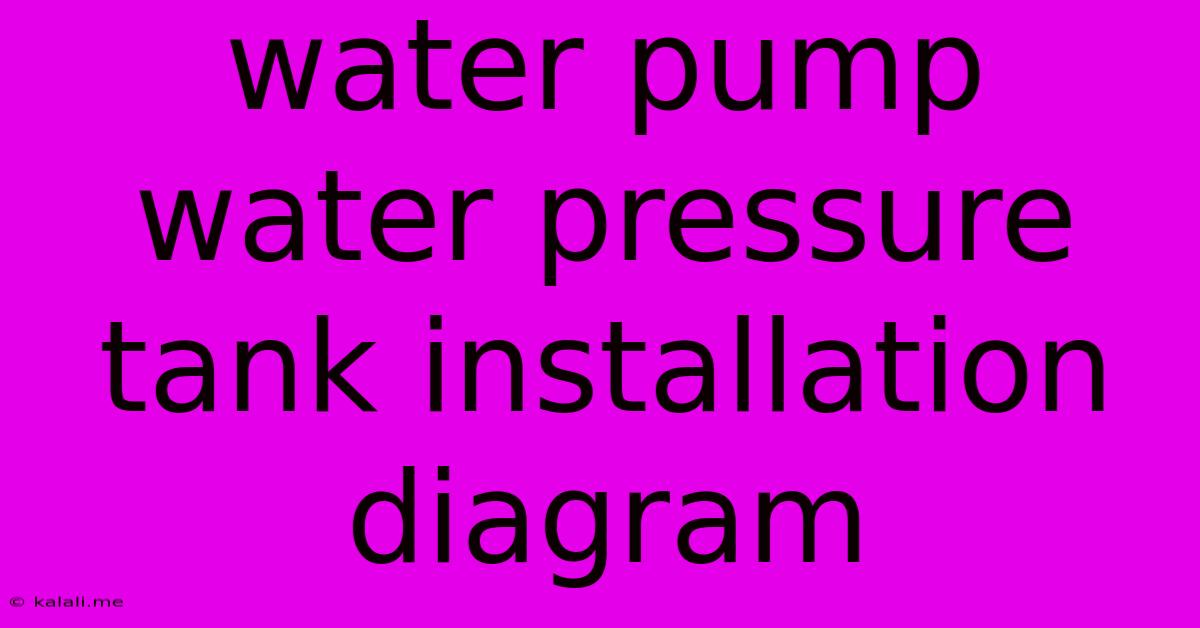Water Pump Water Pressure Tank Installation Diagram
Kalali
Jun 10, 2025 · 4 min read

Table of Contents
Water Pump and Pressure Tank Installation Diagram: A Comprehensive Guide
Meta Description: Learn how to install a water pump and pressure tank with our comprehensive guide, including detailed diagrams and troubleshooting tips. This guide covers everything from choosing the right components to ensuring optimal system performance.
Installing a water pump and pressure tank system can seem daunting, but with a clear understanding of the process and the right tools, it's a manageable DIY project. This guide provides a step-by-step walkthrough, complete with diagrams, to help you successfully install your own water pressure system. We’ll cover selecting the appropriate components, the installation process itself, and essential troubleshooting tips.
Understanding the Components
Before diving into the installation, let’s clarify the key components involved:
-
Water Pump: The heart of the system, responsible for drawing water from the source (well, municipal supply, etc.) and increasing its pressure. Different pumps cater to varying needs – submersible pumps for wells, jet pumps for shallower wells, and centrifugal pumps for larger applications. Choosing the right pump depends on factors like water source depth, required flow rate, and pressure needs.
-
Pressure Tank: This crucial component acts as a buffer, storing pressurized water and minimizing the pump’s cycling on and off. This extends the pump's lifespan and prevents pressure fluctuations. The tank's size is determined by the system's water demand and the pump's capacity. A bladder-type pressure tank is typically preferred for residential applications.
-
Pressure Switch: This device controls the pump's operation, turning it on when pressure drops below a preset level and off when it reaches the upper limit. Correct pressure switch settings are crucial for efficient operation.
-
Pressure Gauge: Provides a visual indication of the system's pressure, allowing for easy monitoring and troubleshooting.
-
Piping and Fittings: Includes pipes (typically PVC or CPVC), valves (check valve, gate valve), and fittings needed to connect all components and ensure a watertight system.
-
Electrical Wiring and Breaker: A dedicated circuit breaker and appropriate wiring are essential for safety and proper pump operation.
Installation Diagram (Simplified)
While a precise diagram depends on your specific setup (e.g., well vs. municipal water), a general representation illustrates the key connections:
[Water Source] ----> [Foot Valve (if applicable)] ----> [Submersible Pump (or intake pipe for other pumps)] ----> [Check Valve] ----> [Pressure Tank] ----> [Pressure Switch] ----> [Pressure Gauge] ----> [House Piping]
^
|
+---[Electrical Wiring to Pump]
Note: This is a simplified representation. You'll likely need additional valves, filters, and possibly a backflow preventer, depending on your local regulations and water source.
Step-by-Step Installation Guide
This is a general outline; consult your specific pump and tank manuals for detailed instructions.
-
Planning and Preparation: Determine the location of the pump and pressure tank. Ensure proper ventilation and accessibility. Obtain all necessary permits.
-
Plumbing Connections: Install the pipes and fittings, connecting the pump, check valve, pressure tank, pressure switch, and pressure gauge securely. Use appropriate pipe sealant and ensure all connections are watertight.
-
Electrical Connections: Connect the pump to a dedicated circuit breaker. Safety First: Always disconnect the power before working on electrical components. Follow all electrical codes and regulations.
-
Pressure Switch Adjustment: Adjust the pressure switch to the manufacturer's recommended settings. This typically involves setting the "cut-in" pressure (when the pump turns on) and the "cut-out" pressure (when the pump turns off).
-
System Testing: Turn on the power and check for leaks. Monitor the pressure gauge to ensure the system is operating correctly.
-
Pressure Tank Charging (if necessary): Some pressure tanks require initial air charging. Refer to your tank's instructions for proper procedure.
Troubleshooting
-
Pump Runs Continuously: Check the pressure switch settings. A faulty pressure switch or a leak in the system could also be the cause.
-
Low Water Pressure: Check for leaks, ensure the pump is receiving sufficient power, and verify the pressure switch settings. A clogged filter or a problem with the water source could also be contributing factors.
-
Pump Doesn't Turn On: Check the power supply, circuit breaker, and wiring. A faulty pressure switch could also prevent the pump from starting.
This guide provides a foundational understanding of water pump and pressure tank installation. Remember to always consult your specific equipment manuals and follow local building codes. If you are uncomfortable performing any of these steps, hiring a qualified plumber is highly recommended.
Latest Posts
Latest Posts
-
What Does Bold Mean On A Coffee Maker
Jun 10, 2025
-
Why Does My Bathroom Sink Smell Like Sewage
Jun 10, 2025
-
Making Fun Of A Serious Situation
Jun 10, 2025
-
How To Get My Cat To Cover His Poop
Jun 10, 2025
-
How Do Blankets Keep You Warm
Jun 10, 2025
Related Post
Thank you for visiting our website which covers about Water Pump Water Pressure Tank Installation Diagram . We hope the information provided has been useful to you. Feel free to contact us if you have any questions or need further assistance. See you next time and don't miss to bookmark.